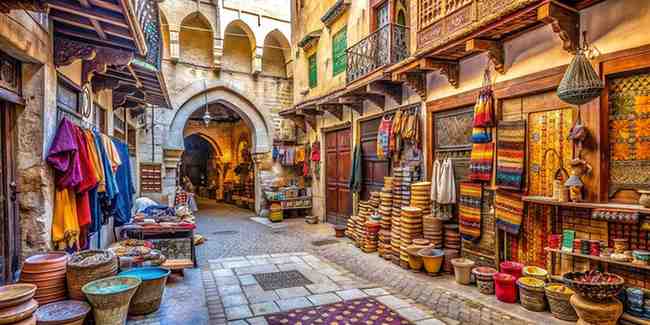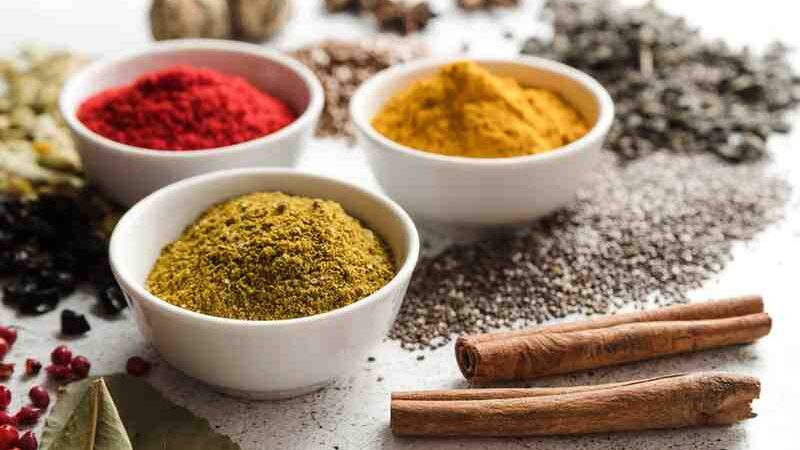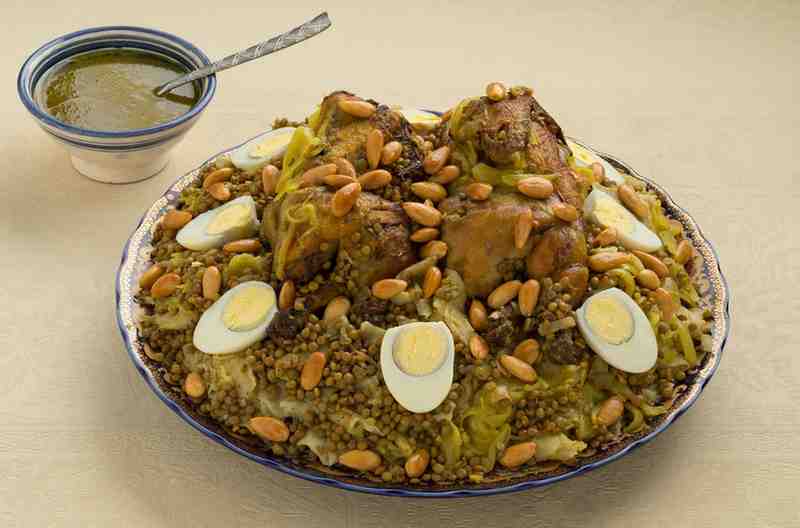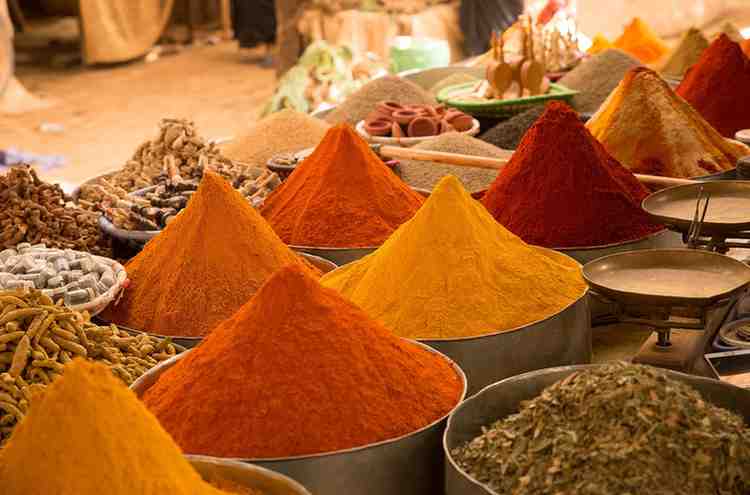Ras el Hanout, which translates to “head of the shop,” is Morocco’s most celebrated spice blend. Often considered the “king of spices” in Morocco, Ras el Hanout represents the finest selection of spices that a merchant offers. It’s a premium blend traditionally reserved for special occasions and showcases Moroccan culinary skill.
In Moroccan cooking, Ras el Hanout provides depth to both savory and sweet dishes. With earthy, floral, and warm notes, it’s a vital seasoning that enriches each meal and reflects Morocco’s love for spices.
Origins of Ras el Hanout and the Influence of Trade Routes
Morocco’s location between Africa, Europe, and the Middle East made it a center of trade, bringing in spices and flavors from different regions. The major cities of Fes, Marrakech, and Essaouira became key hubs, connecting Morocco to a world of exotic ingredients.
The Role of Fes and Marrakech in Shaping Ras el Hanout
Two cities, Fes and Marrakech, played a major role in the development of Ras el Hanout.
- Fes: Known for its bustling markets, Fes welcomed traders from North Africa, the Middle East, and beyond. Spice merchants here experimented with imported spices and local ingredients to create unique flavor profiles.
- Marrakech: Positioned on trans-Saharan trade routes, Marrakech received spices from sub-Saharan Africa, adding more diversity to the local blend.

Coastal Cities and Global Influence
Moroccan coastal cities also influenced Ras el Hanout by introducing new spices from other continents:
- Essaouira: Ships from Europe and Asia brought spices and ideas to Morocco, leading to a greater range of flavors.
- Salé: A busy port that provided access to spices like turmeric and cloves from Asian traders.
Through these ports and cities, Ras el Hanout became a blend that reflects Morocco’s connections to the world.
The Difference Between Ras el Hanout and Mssakhen
While Ras el Hanout is highly regarded in Moroccan cuisine, another blend called Mssakhen is also popular. Each has a different role and distinct ingredients.
Ras el Hanout: A Blend for Celebrations
- Reserved for Special Occasions: Ras el Hanout is often saved for traditional dishes, like pastilla (a savory pastry), tagines, and mrouzia (a lamb and honey dish).
- Luxurious Ingredients: It includes high-quality spices like cardamom, cinnamon, and nutmeg, which create a rich and unique flavor.
Mssakhen: The Everyday Warming Blend
- Everyday Use and Symbolism: Msskhen, meaning “that which warms the body,” is commonly used in winter dishes and for postpartum recovery.
- Comforting Ingredients: This blend contains warming spices like fenugreek, thyme, nutmeg, and galangal.
- Health Benefits: Known for its comforting qualities, especially in cold weather, Msskhen is often added to Rfissa, a dish for postpartum care.
Key Ingredients That Make Each Blend Unique
Ras el Hanout and Msskhen share some spices, but each blend has unique elements:
- Ras el Hanout: Contains exotic spices like cardamom, cinnamon, cumin, and turmeric.
- Mssakhen: Includes warming spices like fenugreek and galangal, which focus on comfort rather than intense flavor.
Key Ingredients in Ras el Hanout and Their Origins
Ras el Hanout’s distinctive taste comes from a mix of core and exotic spices. Each one adds something unique to the blend.
Core Spices
These spices are the main flavors in Ras el Hanout:
- Cardamom: Adds a sweet, fragrant note suitable for both savory and sweet dishes.
- Cinnamon: Brings warmth and sweetness, balancing out earthier spices.
- Cumin: Known for its earthy, slightly bitter taste, cumin adds depth to the blend.
- Turmeric: Offers an earthy flavor and bright yellow color.
- Ginger: Adds a mild spiciness and warmth.
- Cloves: Has a strong, distinct aroma that intensifies the blend’s flavor.
- Nutmeg: Complements the mix with a slightly sweet, warm flavor.
Unique Ingredients for Extra Complexity
Some versions of Ras el Hanout include rare spices, which add interesting layers to the blend:
- Galangal: Has a sharp, citrusy note, similar to ginger but stronger.
- Grains of Paradise: Provides a peppery, citrus-like flavor.
- Rosebuds: Adds a gentle floral sweetness that balances the stronger spices.
- Saffron: Known for its delicate aroma and unique color, saffron gives a subtle luxury to the blend.

The Role of Attarines (Spice Masters) in Crafting Ras el Hanout
In Moroccan markets, especially in Fes and Marrakech, Attarines (spice masters) are experts at creating authentic Ras el Hanout. Each artisan holds a unique recipe, often kept secret and shared only within families.
Artisan Blending: A Time-Honored Tradition
Making Ras el Hanout takes skill and knowledge passed down through generations:
- Family Recipes: Every attarine has a unique recipe, often kept within the family.
- Proportion and Balance: Each spice is carefully measured to create the ideal flavor, texture, and color.
Regional Differences in Flavor
Ras el Hanout blends vary between regions, influenced by local spices and preferences:
- Fes Blends: Known for their bold, aromatic flavors, often highlighting cardamom and cloves.
- Marrakech Blends: May include spices from sub-Saharan Africa, adding unique notes that appeal to local tastes.
Culinary Uses and Traditional Recipes Featuring Ras el Hanout
Ras el Hanout’s unique flavor profile makes it a versatile addition to Moroccan dishes. While it’s widely used in Moroccan cuisine, this spice blend has also gained popularity worldwide, adding depth and warmth to a variety of meals.

Traditional Moroccan Dishes with Ras el Hanout
Ras el Hanout is a central flavor in several iconic Moroccan recipes. Some of the most popular dishes that showcase its richness include:
- Chicken Pastilla: This savory and slightly sweet pie combines shredded chicken with spices, almonds, and a dusting of powdered sugar, making Ras el Hanout essential for the filling’s aromatic flavor.
- Beef or Lamb Tagine: In traditional tagines, Ras el Hanout seasons the meat, blending well with other spices, dried fruits, and vegetables to create a hearty, fragrant dish.
- Mrouzia: A slow-cooked lamb dish with honey, almonds, and Ras el Hanout. This sweet and savory combination highlights the complexity of the spice blend.
- Rfissa: A cherished Moroccan dish of slow-cooked chicken, lentils, and spices like Ras el Hanout and fenugreek, served over torn msemen bread. Often made for special occasions, Rfissa embodies warmth, comfort, and Moroccan hospitality.
Quick and Easy Ways to Use Ras el Hanout at Home
In addition to traditional Moroccan dishes, Ras el Hanout can easily be used in everyday cooking. Some simple ideas include:
- Seasoning for Roasted Vegetables: Toss carrots, sweet potatoes, or cauliflower with olive oil and Ras el Hanout before roasting for an earthy, warm flavor.
- Marinade for Chicken or Lamb: Combine Ras el Hanout with olive oil, garlic, and lemon juice to marinate meats, giving them a delicious Moroccan twist.
- Rice or Grain Dishes: Sprinkle a small amount of Ras el Hanout in rice or couscous for an aromatic and subtly spiced side dish.
Health Benefits of Ras el Hanout
Beyond its flavor, Ras el Hanout offers various health benefits due to the properties of its ingredients. This spice blend has long been valued not only for its taste but also for its potential to support well-being.
Key Health Benefits of Ingredients in Ras el Hanout
Each spice in Ras el Hanout brings unique health benefits that work together to create a nourishing blend:
- Anti-inflammatory Properties: Ingredients like turmeric and ginger reduce inflammation in the body, which can be helpful for conditions like arthritis and joint pain.
- Rich in Antioxidants: Spices like cinnamon and cloves contain antioxidants that protect cells from damage caused by free radicals, supporting overall health.
- Digestive Support: Cumin, ginger, and cardamom are known for aiding digestion, reducing bloating, and easing stomach discomfort.
- Immune Boosting: Many spices in Ras el Hanout, such as cloves and ginger, have antimicrobial properties that may help fight infections and support the immune system.
These health-supporting properties make Ras el Hanout a valued addition to dishes, especially during colder months or as part of a balanced diet.
Note on Traditional Use in Moroccan Medicine
In Moroccan culture, Ras el Hanout has also been used as a tonic for health and vitality. Many Moroccan households incorporate this blend into winter recipes to help maintain warmth and strength. Over time, Ras el Hanout has earned a reputation for contributing to both physical and mental well-being, making it a treasured part of Moroccan traditions.

Modern Culinary Applications and Global Adaptations of Ras el Hanout
Today, Ras el Hanout has found its way into global kitchens, adding an exotic touch to international cuisines. Chefs around the world have adopted this Moroccan blend, creatively incorporating it into fusion dishes and new recipes.
Innovative Ways to Use Ras el Hanout
Ras el Hanout’s versatility allows it to complement a wide range of foods. Here are some creative ways to use it beyond traditional Moroccan dishes:
- Spiced Soups and Stews: Ras el Hanout adds depth to vegetable soups and stews, especially when combined with coconut milk for a creamy texture.
- Rub for Grilled Meats: Mix Ras el Hanout with salt and pepper to create a dry rub for meats, especially chicken and pork, before grilling or roasting.
- Dessert Flavoring: Surprisingly, Ras el Hanout pairs well with sweets. Try adding a small pinch to chocolate desserts, cookies, or cakes for a warm, spicy undertone.
Fusion Cuisine and Global Recipes Featuring Ras el Hanout
The influence of Ras el Hanout has led to its inclusion in a variety of fusion dishes, bringing Moroccan flavors into diverse cuisines:
- Ras el Hanout Hummus: Adding a pinch of Ras el Hanout to hummus offers a Moroccan twist, combining earthy and spicy notes with the creaminess of chickpeas.
- Spiced Flatbreads: Adding Ras el Hanout to flatbread dough creates a warm, flavorful bread that pairs well with dips or can be used as a sandwich base.
- Vegetable Stir-fry: Stir-frying vegetables with a bit of Ras el Hanout and soy sauce creates a unique fusion of Moroccan and Asian flavors.
These adaptations highlight Ras el Hanout’s adaptability and its ability to enrich many types of dishes, adding an unexpected yet welcome flavor to global cuisine.
FAQs about Ras el Hanout
What does Ras el Hanout mean?
- Ras el Hanout translates to “head of the shop,” which signifies the best selection of spices a merchant has to offer.
What are the main ingredients in Ras el Hanout?
- The blend typically includes spices like cardamom, cinnamon, cumin, ginger, and cloves, but it may vary by region and personal preference.
How do you use Ras el Hanout in cooking?
- It’s versatile and can be used in tagines, marinades, soups, stews, roasted vegetables, and even desserts for a Moroccan flavor.
Is Ras el Hanout spicy?
- While it has warm and aromatic notes, Ras el Hanout is not typically very spicy. It is more earthy and slightly sweet.
What is the difference between Ras el Hanout and curry powder?
- Curry powder is a blend used mainly in South Asian cuisine with different spices, while Ras el Hanout is a Moroccan blend that emphasizes warm, floral, and earthy flavors.

